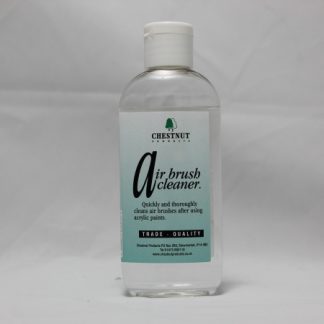 When you need to protect your work but don’t want an overpowering shine on it, Acrylic Satin Lacquer is an ideal choice. With the benefit of an easy aerosol application, especially useful on awkward shapes, this is a hard wearing water based lacquer that will protect whatever it’s put onto, leaving an attractive satin sheen.
Acrylic Satin Lacquer is touch dry and dust free in about five minutes and hard dry about 20 minutes, ready for a second coat if needed after a light cut back with a fine abrasive.
For best results it should be used over either Cellulose Sanding Sealer or the Acrylic Sanding Sealer aerosol.
If you have a change of heart on the finish the lacquer can be brought to a gloss by using either Burnishing Cream or the Buffing Wheel Kit. Or you can simply apply a coat of Acrylic Gloss Lacquer!
When you need to protect your work but don’t want an overpowering shine on it, Acrylic Satin Lacquer is an ideal choice. With the benefit of an easy aerosol application, especially useful on awkward shapes, this is a hard wearing water based lacquer that will protect whatever it’s put onto, leaving an attractive satin sheen.
Acrylic Satin Lacquer is touch dry and dust free in about five minutes and hard dry about 20 minutes, ready for a second coat if needed after a light cut back with a fine abrasive.
For best results it should be used over either Cellulose Sanding Sealer or the Acrylic Sanding Sealer aerosol.
If you have a change of heart on the finish the lacquer can be brought to a gloss by using either Burnishing Cream or the Buffing Wheel Kit. Or you can simply apply a coat of Acrylic Gloss Lacquer!
-
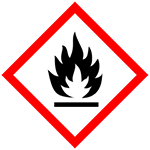
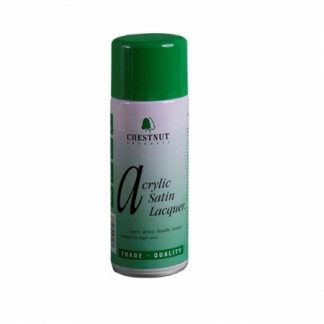
 When you need to protect your work but don’t want an overpowering shine on it, Acrylic Satin Lacquer is an ideal choice. With the benefit of an easy aerosol application, especially useful on awkward shapes, this is a hard wearing water based lacquer that will protect whatever it’s put onto, leaving an attractive satin sheen.
Acrylic Satin Lacquer is touch dry and dust free in about five minutes and hard dry about 20 minutes, ready for a second coat if needed after a light cut back with a fine abrasive.
For best results it should be used over either Cellulose Sanding Sealer or the Acrylic Sanding Sealer aerosol.
If you have a change of heart on the finish the lacquer can be brought to a gloss by using either Burnishing Cream or the Buffing Wheel Kit. Or you can simply apply a coat of Acrylic Gloss Lacquer!
When you need to protect your work but don’t want an overpowering shine on it, Acrylic Satin Lacquer is an ideal choice. With the benefit of an easy aerosol application, especially useful on awkward shapes, this is a hard wearing water based lacquer that will protect whatever it’s put onto, leaving an attractive satin sheen.
Acrylic Satin Lacquer is touch dry and dust free in about five minutes and hard dry about 20 minutes, ready for a second coat if needed after a light cut back with a fine abrasive.
For best results it should be used over either Cellulose Sanding Sealer or the Acrylic Sanding Sealer aerosol.
If you have a change of heart on the finish the lacquer can be brought to a gloss by using either Burnishing Cream or the Buffing Wheel Kit. Or you can simply apply a coat of Acrylic Gloss Lacquer!

-
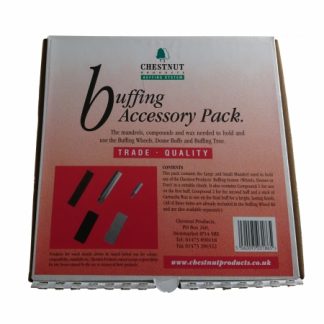 All the items you need to use our Buffing System except the wheels – the perfect add-on when buying the Buffing Tree, the 8 inch wheels or the 4 inch wheels or the Dome Buffs The kit comprises of the Large Mandrel, the Small Mandrel, Compound 1, Compound 2, Carnauba Wax Stick. ALL OF THESE ITEMS ARE INCLUDED IN THE BUFFING WHEEL KIT.
All the items you need to use our Buffing System except the wheels – the perfect add-on when buying the Buffing Tree, the 8 inch wheels or the 4 inch wheels or the Dome Buffs The kit comprises of the Large Mandrel, the Small Mandrel, Compound 1, Compound 2, Carnauba Wax Stick. ALL OF THESE ITEMS ARE INCLUDED IN THE BUFFING WHEEL KIT. -
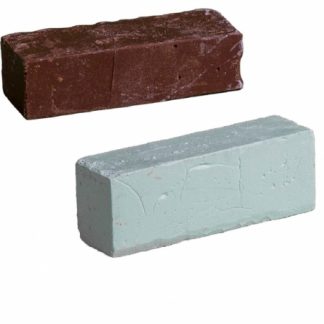 These compounds are designed to co-ordinate with the cloth used in the Buffing Wheels and Dome Buffs to give an exceptional cut and prepare the surface to a very smooth finish prior to using wax. Compound 1 -the brown one – (sometimes referred to as tripoli) is used with the ‘A’ Wheel/Dome to help smooth the applied finish. Avoid overloading the wheel/dome where possible to prevent a build up of the compound. If this happens it can be removed by either washing in soapy water or abrading the edge of the wheel with a coarse abrasive. Do not use on very open grained light coloured timber as the compound can get lodged in the grain and colour the piece. Compound 2 – the white one – (sometimes referred to as white diamond) acts as a cleanser to remove any traces of Compound 1 left on the surface (but not from the grain) and also has a very fine abrasive contained in it which smooths the work, leaving a semi-gloss finish and a superb foundation for the top coat of wax. Use Compound 2 sparingly, too much on the wheel will result in smears on the surface of your work which can be removed with buffing but this can be very time consuming and frustrating. It’s always best to apply a little and add more if needed.
These compounds are designed to co-ordinate with the cloth used in the Buffing Wheels and Dome Buffs to give an exceptional cut and prepare the surface to a very smooth finish prior to using wax. Compound 1 -the brown one – (sometimes referred to as tripoli) is used with the ‘A’ Wheel/Dome to help smooth the applied finish. Avoid overloading the wheel/dome where possible to prevent a build up of the compound. If this happens it can be removed by either washing in soapy water or abrading the edge of the wheel with a coarse abrasive. Do not use on very open grained light coloured timber as the compound can get lodged in the grain and colour the piece. Compound 2 – the white one – (sometimes referred to as white diamond) acts as a cleanser to remove any traces of Compound 1 left on the surface (but not from the grain) and also has a very fine abrasive contained in it which smooths the work, leaving a semi-gloss finish and a superb foundation for the top coat of wax. Use Compound 2 sparingly, too much on the wheel will result in smears on the surface of your work which can be removed with buffing but this can be very time consuming and frustrating. It’s always best to apply a little and add more if needed. -
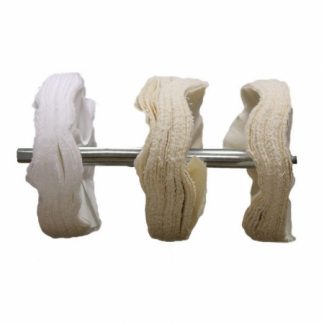 The Buffing Tree comprises of three 6 inch wheels, in the A, B and C cloth grades, firmly held on a central spindle. It’s ideal for buffing small items and, after loading the wheels with the compounds and wax, allows you to move from one wheel to the next in quick succession, dramatically reducing the time otherwise taken up by changing wheels. Ideal for polishing small items such as fruit, pens, boxes etc in batches. Requires one of our mandrels to fix to the chuck and a live centre for support at the tailstock. PLEASE NOTE: The Buffing Tree does not come as kit containing the mandrels and compounds etc; this is deliberate as if you already use the Buffing System you will have these and won’t want to buy them again. If you do not have these items they are available to purchase separately or as a pack in the Buffing Accessory Pack.
The Buffing Tree comprises of three 6 inch wheels, in the A, B and C cloth grades, firmly held on a central spindle. It’s ideal for buffing small items and, after loading the wheels with the compounds and wax, allows you to move from one wheel to the next in quick succession, dramatically reducing the time otherwise taken up by changing wheels. Ideal for polishing small items such as fruit, pens, boxes etc in batches. Requires one of our mandrels to fix to the chuck and a live centre for support at the tailstock. PLEASE NOTE: The Buffing Tree does not come as kit containing the mandrels and compounds etc; this is deliberate as if you already use the Buffing System you will have these and won’t want to buy them again. If you do not have these items they are available to purchase separately or as a pack in the Buffing Accessory Pack. -
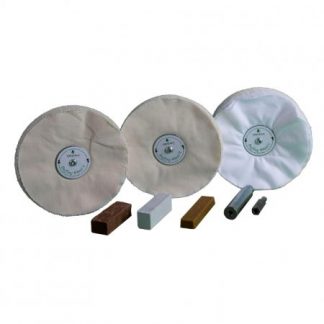 This kit gets you started on the road to buffing – all you need to supply is the lathe, a chuck and something to buff! Inside the kit you get the mandrels for holding the Buffing Wheels in the chuck. One of each buffing wheel (A, B and C) are included in the 8 inch size, complete with all the fixings attached to fit into the Mandrels. A bar of each of the compounds is included to get you started, these will last a long time so no need to worry about getting spares yet (although all of the items in the kit are available separately when you need to get them). Next is a stick of carnauba wax for that final gloss finish. Last but not least is a full set of instructions on how to use the kit to get the best from it.
This kit gets you started on the road to buffing – all you need to supply is the lathe, a chuck and something to buff! Inside the kit you get the mandrels for holding the Buffing Wheels in the chuck. One of each buffing wheel (A, B and C) are included in the 8 inch size, complete with all the fixings attached to fit into the Mandrels. A bar of each of the compounds is included to get you started, these will last a long time so no need to worry about getting spares yet (although all of the items in the kit are available separately when you need to get them). Next is a stick of carnauba wax for that final gloss finish. Last but not least is a full set of instructions on how to use the kit to get the best from it. -

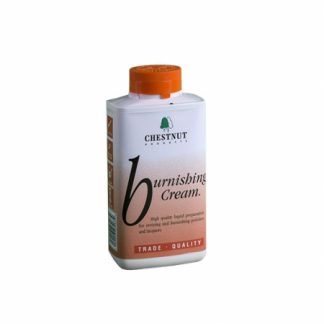 This creamy liquid has a very mild abrasive within it which acts like ‘liquid sandpaper’ on finished surfaces, cutting back and cleaning the finish and elevating it to a glossier, brighter finish. It can be used to smooth Cellulose Sanding Sealer prior to applying wax or Friction Polish, or, after allowing a suitable time to dry, on any of the lacquers, Friction Polish, Finishing Oil or Hard Wax Oil. A deep finish can be achieved using Burnishing Cream on a coat of Melamine Lacquer, then a coat of Friction Polish and finally the Burnishing Cream again. Use it sparingly so as not to over lubricate the surface and be sure to shake the bottle before use. It is not advisable to use a lacquer on top of a surface that has had Burnishing Cream used on it.
This creamy liquid has a very mild abrasive within it which acts like ‘liquid sandpaper’ on finished surfaces, cutting back and cleaning the finish and elevating it to a glossier, brighter finish. It can be used to smooth Cellulose Sanding Sealer prior to applying wax or Friction Polish, or, after allowing a suitable time to dry, on any of the lacquers, Friction Polish, Finishing Oil or Hard Wax Oil. A deep finish can be achieved using Burnishing Cream on a coat of Melamine Lacquer, then a coat of Friction Polish and finally the Burnishing Cream again. Use it sparingly so as not to over lubricate the surface and be sure to shake the bottle before use. It is not advisable to use a lacquer on top of a surface that has had Burnishing Cream used on it.
-
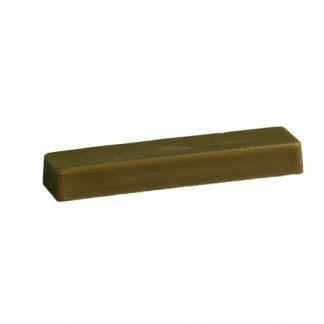 This is a solid block of carnauba wax, popular with woodturners. It gives a bright gloss finish and is also very hard wearing, able to withstand a medium amount of handling without showing finger marks. Apply over a sanding sealer by holding it against your work at it revolves on the lathe. Do not press too much – the wax is very hard and can scratch softer woods – the idea is to generate enough heat for the wax to melt slightly and transfer onto the wood. (This is easier than it sounds!). Use sparingly, and use the polishing process (using safety cloth) to ensure the wax is spread evenly. Buffing will produce a high gloss finish.
This is a solid block of carnauba wax, popular with woodturners. It gives a bright gloss finish and is also very hard wearing, able to withstand a medium amount of handling without showing finger marks. Apply over a sanding sealer by holding it against your work at it revolves on the lathe. Do not press too much – the wax is very hard and can scratch softer woods – the idea is to generate enough heat for the wax to melt slightly and transfer onto the wood. (This is easier than it sounds!). Use sparingly, and use the polishing process (using safety cloth) to ensure the wax is spread evenly. Buffing will produce a high gloss finish. -

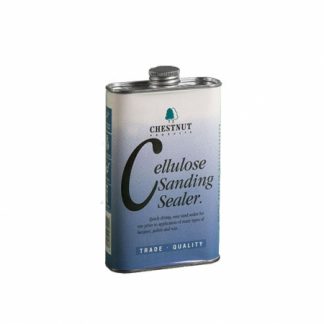
 Good finishing requires a good foundation, and Cellulose Sanding Sealer is probably the best way of providing one. Compatible with everything in the Chestnut Products range that benefits from the use of a sanding sealer (which is pretty much everything apart from oil finishes!) it is superbly universal.
The purpose of a sanding sealer is manifold.
Good finishing requires a good foundation, and Cellulose Sanding Sealer is probably the best way of providing one. Compatible with everything in the Chestnut Products range that benefits from the use of a sanding sealer (which is pretty much everything apart from oil finishes!) it is superbly universal.
The purpose of a sanding sealer is manifold.
- It seals the open pores of the timber prior to the application of the next coat, meaning that more of it stays on the surface and less of the finish is needed. Not only does this make it economical, when finishing the thinner the applied coat the less likely it is to get damaged, so a sanding sealer will help the top coats be more resilient.
- Sanding Sealers also bind the loose fibres of the timber together giving a more solid foundation for the next coat, which helps make sure the final finish is able to adhere properly and thus be more durable.
- They also include a sanding agent which acts as a lubricant to make the sanding process easier – the sanding agent also stands slightly proud of the surface of the sealer and it is this that is denibbed – the sealer itself should still be intact after sanding.

-

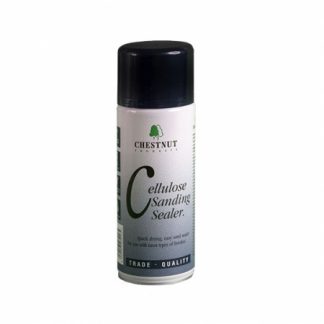
 Getting a good base for your finishing is essential when you want to get a great finish. Sometimes the piece you’re working on makes that more difficult due to its shape or size or for many other reasons.
Or sometimes you just want a quicker, cleaner method of applying a sealer.
That’s where Cellulose Sanding Sealer in an aerosol comes into its own. Basically the same product as in the tin, it has all the same benefits of quick drying and universal compatibility, it also has the added advantage of being easier both to apply and to get an even coating.
Use it before applying waxes, lacquers and polishes for a more durable final finish.
Getting a good base for your finishing is essential when you want to get a great finish. Sometimes the piece you’re working on makes that more difficult due to its shape or size or for many other reasons.
Or sometimes you just want a quicker, cleaner method of applying a sealer.
That’s where Cellulose Sanding Sealer in an aerosol comes into its own. Basically the same product as in the tin, it has all the same benefits of quick drying and universal compatibility, it also has the added advantage of being easier both to apply and to get an even coating.
Use it before applying waxes, lacquers and polishes for a more durable final finish.

-

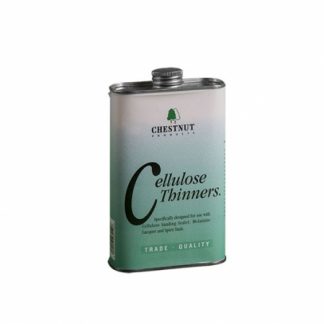 This pure cellulose solvent is a high quality dilutant for our cellulose based products, such as Cellulose Sanding Sealer and Melamine Lacquer. Thinning these products can help to make them easier to apply, especially over larger areas as it helps them flow out. Cellulose Thinners is also useful for cleaning any spills you may have in the workshop and is strong enough to help clean most things, taking care to ensure that it does not attack It can also be used to thin Spirit Stain to give a delicate wash effects, although spirit thinners is the better option for this.
This pure cellulose solvent is a high quality dilutant for our cellulose based products, such as Cellulose Sanding Sealer and Melamine Lacquer. Thinning these products can help to make them easier to apply, especially over larger areas as it helps them flow out. Cellulose Thinners is also useful for cleaning any spills you may have in the workshop and is strong enough to help clean most things, taking care to ensure that it does not attack It can also be used to thin Spirit Stain to give a delicate wash effects, although spirit thinners is the better option for this.
-

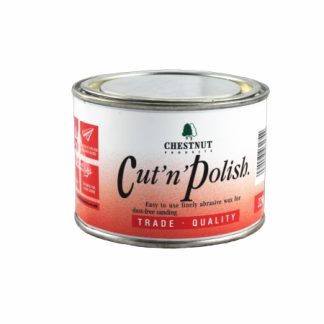 Cut’n’Polish is a blend of two waxes with a fine abrasive held in suspension within them. This is a soft wax designed to stay ‘wet’ slightly longer during application, allowing it to lubricate the abrasive to give a very fine cut to the timber and also to collect any dust generated during use and some subsequent sanding, preventing it from entering the workshop atmosphere. On bare wood; sand to 240 grit as normal, apply a coat of Cut’n’Polish with the lathe stopped, then switch on the lathe and buff to a soft sheen whilst smoothing the timber at the same time. On sealed wood apply after the sealer in the same way, polishing to a slightly higher shine. Cut’n’Polish dries almost immediately and can be overcoated with Friction Polish or any Chestnut waxes for a higher shine.
Cut’n’Polish is a blend of two waxes with a fine abrasive held in suspension within them. This is a soft wax designed to stay ‘wet’ slightly longer during application, allowing it to lubricate the abrasive to give a very fine cut to the timber and also to collect any dust generated during use and some subsequent sanding, preventing it from entering the workshop atmosphere. On bare wood; sand to 240 grit as normal, apply a coat of Cut’n’Polish with the lathe stopped, then switch on the lathe and buff to a soft sheen whilst smoothing the timber at the same time. On sealed wood apply after the sealer in the same way, polishing to a slightly higher shine. Cut’n’Polish dries almost immediately and can be overcoated with Friction Polish or any Chestnut waxes for a higher shine.
-
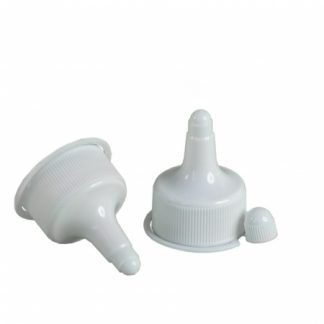 These Dispensing Nozzles are, in fact, almost indispensable! They fit onto any of Chestnuts' plastic bottles in the 250ml, 500ml and 1 ltr sizes, simply replacing the existing cap. Cut the tip off to the size you want and use the handy cover to reseal them when not in use. A useful by product of using these is that if you knock a bottle over the amount you lose through the small nozzle will be much less than without it. Just don’t forget to take the nozzle off the bottle before you throw it away so that you can re-use it! These nozzles are not child resistant, the correct closure should be replaced when the product is not in use.
These Dispensing Nozzles are, in fact, almost indispensable! They fit onto any of Chestnuts' plastic bottles in the 250ml, 500ml and 1 ltr sizes, simply replacing the existing cap. Cut the tip off to the size you want and use the handy cover to reseal them when not in use. A useful by product of using these is that if you knock a bottle over the amount you lose through the small nozzle will be much less than without it. Just don’t forget to take the nozzle off the bottle before you throw it away so that you can re-use it! These nozzles are not child resistant, the correct closure should be replaced when the product is not in use. -
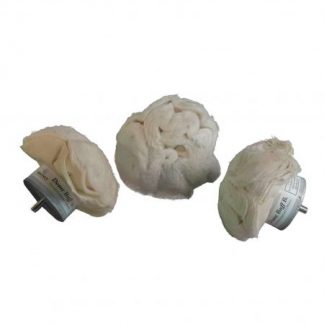 These unstitched, cotton mops are ideal for polishing the insides of bowls and boxes etc to achieve the same great finish on the inside as on the outside when using the Buffing Wheel kit, without the fear of the item being snatched from your hands by the larger Buffing Wheels. All of the domes share the same thread as in the large mandrel and the small mandrel so all parts are completely interchangeable. Due to the smaller size of these dome buffs they will require more time and sometimes more speed on the lathe to be able to match the finish given by the larger wheels. Dome Buff A is used with compound 1 to cut back the applied finish and remove any minor blemishes left behind by sanding. Dome Buff B is used with Compound 2 to cleanse the piece and also to prepare for the final polish coat by giving an exceptionally smooth surface. Dome Buff C is used with either the Carnauba wax stick, microcrystalline wax or Microcrystalline Wax Stick to give a wonderful, long lasting shine.
These unstitched, cotton mops are ideal for polishing the insides of bowls and boxes etc to achieve the same great finish on the inside as on the outside when using the Buffing Wheel kit, without the fear of the item being snatched from your hands by the larger Buffing Wheels. All of the domes share the same thread as in the large mandrel and the small mandrel so all parts are completely interchangeable. Due to the smaller size of these dome buffs they will require more time and sometimes more speed on the lathe to be able to match the finish given by the larger wheels. Dome Buff A is used with compound 1 to cut back the applied finish and remove any minor blemishes left behind by sanding. Dome Buff B is used with Compound 2 to cleanse the piece and also to prepare for the final polish coat by giving an exceptionally smooth surface. Dome Buff C is used with either the Carnauba wax stick, microcrystalline wax or Microcrystalline Wax Stick to give a wonderful, long lasting shine. -
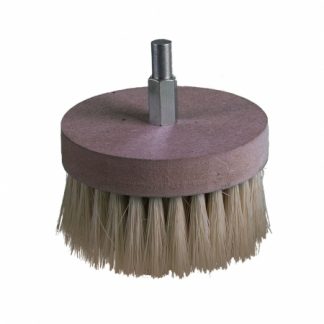 Chestnut Drill Polishing Brush has natural bristles that might seem a little harsh for polishing waxes but in fact are ideal for the task. Chestnut Drill Polishing Brush, which fits any electric drill or can also be used with the Buffing Wheel System, will give a higher gloss and more resilient finish to any waxed piece. In use, the bristles splay out in a mushroom shape, making this brush ideal for polishing spindles and cylinders. It can be used on flat surfaces but is prone to leave rings so the drum brush or dome brush are recommended for this application. The stock of the brush is about 10cm and the bristles are 4cm long. If the bristles of the brush become clogged with wax simply wash it in warm soapy water and allow to dry before use.
Chestnut Drill Polishing Brush has natural bristles that might seem a little harsh for polishing waxes but in fact are ideal for the task. Chestnut Drill Polishing Brush, which fits any electric drill or can also be used with the Buffing Wheel System, will give a higher gloss and more resilient finish to any waxed piece. In use, the bristles splay out in a mushroom shape, making this brush ideal for polishing spindles and cylinders. It can be used on flat surfaces but is prone to leave rings so the drum brush or dome brush are recommended for this application. The stock of the brush is about 10cm and the bristles are 4cm long. If the bristles of the brush become clogged with wax simply wash it in warm soapy water and allow to dry before use. -

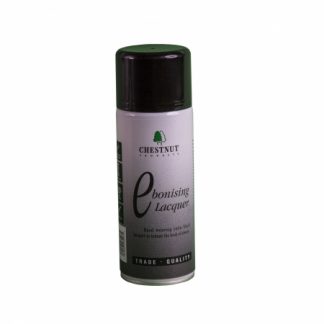
 Ebonising Lacquer is a tough, hard-wearing water-based lacquer. It is heavily pigmented so that when it is dry it emulates the classic satin look of ebony.
Usually applied over a sanding sealer (either Cellulose Sanding Sealer or Acrylic Sanding Sealer aerosol) it is touch dry in about five minutes and hard dry after twenty minutes.
Although heavily pigmented it is not paint and will still allow the grain of the timber to show through, rather than obliterating it completely.
Liming Wax and Gilt Cream can be applied over Ebonising Lacquer to give a pleasing, eye-catching yet very simple artistic effect.
If a bright gloss finish is required from Ebonising Lacquer this is best achieved by using Burnishing Cream on the lacquer with will polish it up to a high gloss.
Acrylic Gloss Lacquer can also be applied on top of Ebonising Lacquer, as can WoodWax 22 and Microcrystalline Wax.
Ebonising Lacquer is a tough, hard-wearing water-based lacquer. It is heavily pigmented so that when it is dry it emulates the classic satin look of ebony.
Usually applied over a sanding sealer (either Cellulose Sanding Sealer or Acrylic Sanding Sealer aerosol) it is touch dry in about five minutes and hard dry after twenty minutes.
Although heavily pigmented it is not paint and will still allow the grain of the timber to show through, rather than obliterating it completely.
Liming Wax and Gilt Cream can be applied over Ebonising Lacquer to give a pleasing, eye-catching yet very simple artistic effect.
If a bright gloss finish is required from Ebonising Lacquer this is best achieved by using Burnishing Cream on the lacquer with will polish it up to a high gloss.
Acrylic Gloss Lacquer can also be applied on top of Ebonising Lacquer, as can WoodWax 22 and Microcrystalline Wax.

-
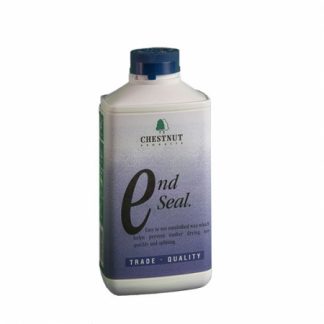 End Seal is an emulsified paraffin wax used the seal the ends of freshly cut timber to slow down the drying process and reduce the risk of the timber splitting. It can also be used on work-in-progress that is being left unfinished where there is a risk of the timber splitting. Apply it liberally, normally by brush but it can be sprayed if needed, usually to the smallest surface of the timber which will normally be the end grain where moisture is most likely to escape from. Sealing the surface will encourage the moisture to escape via the larger areas which will result in a slower exit.
End Seal is an emulsified paraffin wax used the seal the ends of freshly cut timber to slow down the drying process and reduce the risk of the timber splitting. It can also be used on work-in-progress that is being left unfinished where there is a risk of the timber splitting. Apply it liberally, normally by brush but it can be sprayed if needed, usually to the smallest surface of the timber which will normally be the end grain where moisture is most likely to escape from. Sealing the surface will encourage the moisture to escape via the larger areas which will result in a slower exit. -

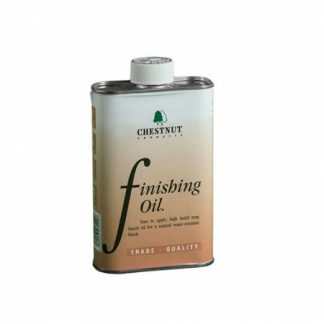
 Chestnut Finishing Oil is Chestnuts' version of Danish Oil* and uses Tung Oil as its base but with the addition of solvents and driers. This aids the drying of the product and speeds it up dramatically, so that it’s dry within eight hours. It has a pale amber colour and dries to a hard yet flexible film which is very hardwearing and water resistant.
For a high gloss finish apply several coats with a light rub down between coats; after 5 or 6 coats a good sheen should be visible.
Finishing Oil is normally applied by cloth but on larger areas a brush can be used very successfully.
Chestnut Finishing Oil is Chestnuts' version of Danish Oil* and uses Tung Oil as its base but with the addition of solvents and driers. This aids the drying of the product and speeds it up dramatically, so that it’s dry within eight hours. It has a pale amber colour and dries to a hard yet flexible film which is very hardwearing and water resistant.
For a high gloss finish apply several coats with a light rub down between coats; after 5 or 6 coats a good sheen should be visible.
Finishing Oil is normally applied by cloth but on larger areas a brush can be used very successfully.

-
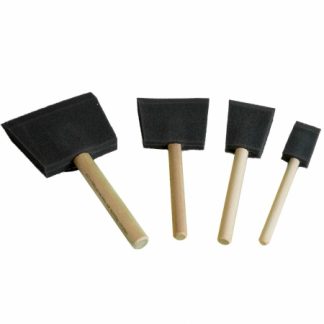 Made in the USA, these are the original and best quality Foam Brush. Manufactured using a special foam with a stiffener inside to make sure they keep their shape in use, and supplied with a solid wooden handle attached. Great for eliminating brush marks (no bristles = no brush marks) and there’s no danger of any stray bristles coming loose and spoiling your work. Priced to be semi-disposable they will normally wash out several times for re-use. Fantastic for applying acrylic finishes which have a tendency to froth up when applied by brush – the Foam Brush virtually eliminates this completely. Can also be used for painting, particularly gloss paints, seasoned users have been known to have a brush in each hand!
Made in the USA, these are the original and best quality Foam Brush. Manufactured using a special foam with a stiffener inside to make sure they keep their shape in use, and supplied with a solid wooden handle attached. Great for eliminating brush marks (no bristles = no brush marks) and there’s no danger of any stray bristles coming loose and spoiling your work. Priced to be semi-disposable they will normally wash out several times for re-use. Fantastic for applying acrylic finishes which have a tendency to froth up when applied by brush – the Foam Brush virtually eliminates this completely. Can also be used for painting, particularly gloss paints, seasoned users have been known to have a brush in each hand! -

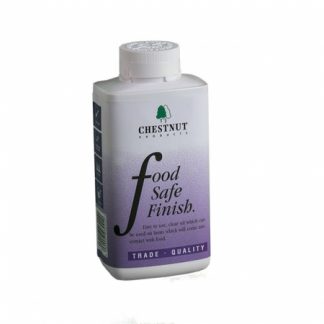 Food Safe Finish is a clear, food grade mineral oil. Chestnut use a thin grade of oil to allow it to soak into bare timber which then protects it against water splashes etc whilst not tainting or affecting the food in any way. It dries to a fairly matt finish; it is however ideal to use for wet sanding and when used with a very fine abrasive it can give an exceptionally smooth surface which has its own gentle glow. Apply with a clean cloth or brush direct onto bare wood, up to three coats are recommended. If the oil sits on the surface and won’t soak in it means the timber has absorbed as much as it can and no further coats are needed. Any surplus can be removed with a clean cloth if required. Depending on the way the item is used it might be necessary to top-up the finish, especially if it is washed regularly.
Food Safe Finish is a clear, food grade mineral oil. Chestnut use a thin grade of oil to allow it to soak into bare timber which then protects it against water splashes etc whilst not tainting or affecting the food in any way. It dries to a fairly matt finish; it is however ideal to use for wet sanding and when used with a very fine abrasive it can give an exceptionally smooth surface which has its own gentle glow. Apply with a clean cloth or brush direct onto bare wood, up to three coats are recommended. If the oil sits on the surface and won’t soak in it means the timber has absorbed as much as it can and no further coats are needed. Any surplus can be removed with a clean cloth if required. Depending on the way the item is used it might be necessary to top-up the finish, especially if it is washed regularly.
-

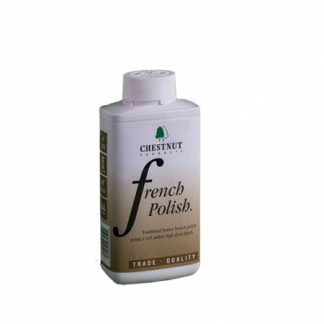 Confusingly, French Polish refers to a range of polishes (which would include Button Polish, White Polish, Garnet Polish etc) and also to a specific polish, French Polish. Chestnuts' French Polish is a traditional blend of solvent (methylated spirit) and a top quality unbleached shellac which is very similar to a Button Polish in colour. Applied either to bare timber or over a Shellac Sanding Sealer it is built up in many layers which have been described as being the thickness of a cigarette paper! French Polish gives the rich amber glow found on fine antique furniture and requires a very specific technique for application that is time consuming and laborious, but the final effect has to be seen to be believed and the satisfaction of achieving it is its own reward. A French Polish finish is not very hard wearing and is recommended for items that are going to be cared for.
Confusingly, French Polish refers to a range of polishes (which would include Button Polish, White Polish, Garnet Polish etc) and also to a specific polish, French Polish. Chestnuts' French Polish is a traditional blend of solvent (methylated spirit) and a top quality unbleached shellac which is very similar to a Button Polish in colour. Applied either to bare timber or over a Shellac Sanding Sealer it is built up in many layers which have been described as being the thickness of a cigarette paper! French Polish gives the rich amber glow found on fine antique furniture and requires a very specific technique for application that is time consuming and laborious, but the final effect has to be seen to be believed and the satisfaction of achieving it is its own reward. A French Polish finish is not very hard wearing and is recommended for items that are going to be cared for.
-

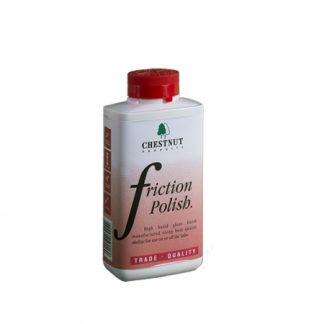 Friction Polish is a shellac based polish ideal for creating a high gloss finish on or off the lathe. It’s a great decorative finish and is ideal for small items but can be difficult to apply to larger items on the lathe (over about 8 inch diameter). The high amount of shellac in Friction Polish does two main things. Firstly it helps seal bare wood and give it a great shine, which is good. Sadly the price of this commodity shot up a few years ago when the shellac crop failed and it never went back down, meaning that the cost of the polish has also risen sharply. Nevertheless, Friction Polish remains one of the most popular finishes for turners. It can be applied to bare wood but is normally used over a sealer and any of the sealers in the Chestnut Products range are suitable for this. Applied with the lathe running it dries almost instantly and builds to a deep, rich shine very quickly. Avoid using too much as this can cause ‘rings’ to appear on the surface. Friction Polish can be applied off the lathe with great success, using it like a French Polish and rubbing it into the surface. This does require a large amount of elbow grease (sadly not something we supply) but the end result is well worth the effort!
Friction Polish is a shellac based polish ideal for creating a high gloss finish on or off the lathe. It’s a great decorative finish and is ideal for small items but can be difficult to apply to larger items on the lathe (over about 8 inch diameter). The high amount of shellac in Friction Polish does two main things. Firstly it helps seal bare wood and give it a great shine, which is good. Sadly the price of this commodity shot up a few years ago when the shellac crop failed and it never went back down, meaning that the cost of the polish has also risen sharply. Nevertheless, Friction Polish remains one of the most popular finishes for turners. It can be applied to bare wood but is normally used over a sealer and any of the sealers in the Chestnut Products range are suitable for this. Applied with the lathe running it dries almost instantly and builds to a deep, rich shine very quickly. Avoid using too much as this can cause ‘rings’ to appear on the surface. Friction Polish can be applied off the lathe with great success, using it like a French Polish and rubbing it into the surface. This does require a large amount of elbow grease (sadly not something we supply) but the end result is well worth the effort!
-

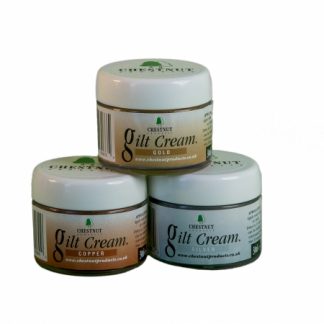 Gilt Creams are a creamy, waxy paste with metallic flakes and pigments in them, giving a rich, lustrous finish to whatever they are applied to. The can be used for a ‘limed’ effect over a lacquer to give a high contrast effect, or uniformly over a piece and polished to a bright shine once dried. Available in
Gilt Creams are a creamy, waxy paste with metallic flakes and pigments in them, giving a rich, lustrous finish to whatever they are applied to. The can be used for a ‘limed’ effect over a lacquer to give a high contrast effect, or uniformly over a piece and polished to a bright shine once dried. Available in- Gold
- Silver
- Copper

-

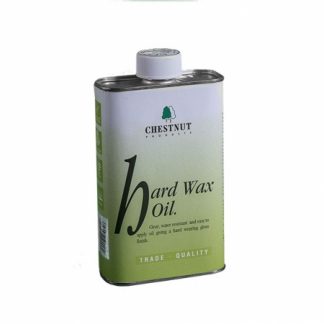
 If you’re looking for a clear finish that is tough, hardwearing and gives a bright gloss yet is still very easy to apply, even on larger areas, you’re in the right place.
Hard Wax Oil is a particular blend of tough oils combined with special waxes which dries to an exceptionally resilient finish. Ideal for anything that is going to be subjected to water splashes or a lot of handling this oil may not be indestructible but it will stand up to a lot of abuse.
It retains the ease of application typical of an oil and it stays wet long enough to get a smooth, even finish – even on large areas – but is touch dry and tack free in about 20 minutes, and better yet is ready for a second coat after about four hours (in normal conditions).
Hard Wax Oil will build to a bright gloss finish after 2-3 coats. Rub down lightly between coats with a fine abrasive. Once hard dry (allow at least 24 hours) it can be brought to an even brighter shine using either the buffing wheel system or burnishing cream.
For a not-quite-so-bright finish use a mild abrasive to reduce the gloss. For best results lubricate the abrasive with microcrystalline wax to retain the toughness of the oil.
If you’re looking for a clear finish that is tough, hardwearing and gives a bright gloss yet is still very easy to apply, even on larger areas, you’re in the right place.
Hard Wax Oil is a particular blend of tough oils combined with special waxes which dries to an exceptionally resilient finish. Ideal for anything that is going to be subjected to water splashes or a lot of handling this oil may not be indestructible but it will stand up to a lot of abuse.
It retains the ease of application typical of an oil and it stays wet long enough to get a smooth, even finish – even on large areas – but is touch dry and tack free in about 20 minutes, and better yet is ready for a second coat after about four hours (in normal conditions).
Hard Wax Oil will build to a bright gloss finish after 2-3 coats. Rub down lightly between coats with a fine abrasive. Once hard dry (allow at least 24 hours) it can be brought to an even brighter shine using either the buffing wheel system or burnishing cream.
For a not-quite-so-bright finish use a mild abrasive to reduce the gloss. For best results lubricate the abrasive with microcrystalline wax to retain the toughness of the oil.

-


 If you’re looking for a clear finish that is tough, hardwearing and gives a satin lustre yet is still very easy to apply, even on larger areas, you’re in the right place.
Hard Wax Oil is a particular blend of tough oils combined with special waxes which dries to an exceptionally resilient finish. Ideal for anything that is going to be subjected to water splashes or a lot of handling this oil may not be indestructible but it will stand up to a lot of abuse.
It retains the ease of application typical of an oil and it stays wet long enough to get a smooth, even finish – even on large areas – but is touch dry and tack free in about 20 minutes, and better yet is ready for a second coat after about four hours (in normal conditions).
Hard Wax Oil will build to a bright gloss finish after 2-3 coats. Rub down lightly between coats with a fine abrasive. Once hard dry (allow at least 24 hours) it can be brought to an even brighter shine using either the buffing wheel system or burnishing cream.
For a not-quite-so-bright finish use a mild abrasive to reduce the gloss. For best results lubricate the abrasive with microcrystalline wax to retain the toughness of the oil.
If you’re looking for a clear finish that is tough, hardwearing and gives a satin lustre yet is still very easy to apply, even on larger areas, you’re in the right place.
Hard Wax Oil is a particular blend of tough oils combined with special waxes which dries to an exceptionally resilient finish. Ideal for anything that is going to be subjected to water splashes or a lot of handling this oil may not be indestructible but it will stand up to a lot of abuse.
It retains the ease of application typical of an oil and it stays wet long enough to get a smooth, even finish – even on large areas – but is touch dry and tack free in about 20 minutes, and better yet is ready for a second coat after about four hours (in normal conditions).
Hard Wax Oil will build to a bright gloss finish after 2-3 coats. Rub down lightly between coats with a fine abrasive. Once hard dry (allow at least 24 hours) it can be brought to an even brighter shine using either the buffing wheel system or burnishing cream.
For a not-quite-so-bright finish use a mild abrasive to reduce the gloss. For best results lubricate the abrasive with microcrystalline wax to retain the toughness of the oil.

-
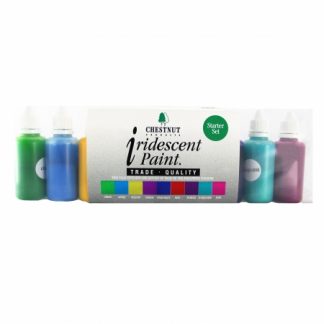 Iridescent Paints give a change in hue, a slight colour shift when viewed from different angles and are especially effective on irregularly shaped items.Available in nine different amazingly bright and vibrant colours –
Iridescent Paints give a change in hue, a slight colour shift when viewed from different angles and are especially effective on irregularly shaped items.Available in nine different amazingly bright and vibrant colours –- Green
- Azure
- Purple
- Red
- Turquoise
- Cerise
- Pink
- Yellow
- Vivid Blue
The paints are water based acrylics and can be applied by brush, cloth, spray gun/airbrush or any manner of ways to give interesting decorative effects. -
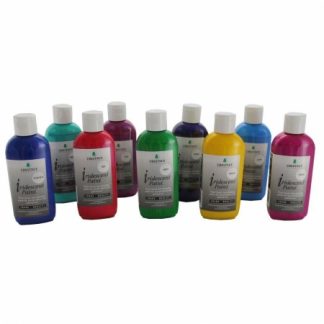 Iridescent Paints give a change in hue, a slight colour shift when viewed from different angles and are especially effective on irregularly shaped items.Available in nine different amazingly bright and vibrant colours –
Iridescent Paints give a change in hue, a slight colour shift when viewed from different angles and are especially effective on irregularly shaped items.Available in nine different amazingly bright and vibrant colours –- Green
- Azure
- Purple
- Red
- Turquoise
- Cerise
- Pink
- Yellow
- Vivid Blue
The paints are water based acrylics and can be applied by brush, cloth, spray gun/airbrush or any manner of ways to give interesting decorative effects. -

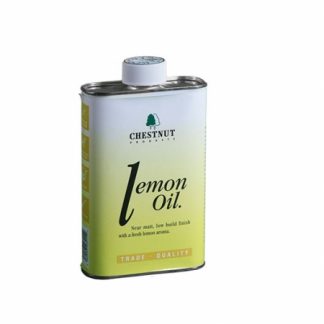 If you’re looking for a finish that won’t change the colour of your timber, won’t overpower the natural beauty of the wood with a high gloss but will still protect the timber and smell nice, well, you’re in the right place! Lemon Oil is a clear, low build finish. By that we mean that it’s a very thin liquid with a very low solids content, so no matter how much you apply it’s not going to build up to a discernible visible film on the surface. Instead it soaks in and seals the surface, offering a level of water resistance and protection against handling. Normally applied with a brush or a cloth it’s very easy to use and covers well and doesn’t usually show overlaps, so it’s ideal for large areas which often look better without a high gloss. And as you might expect, it has a pleasant lemon aroma too, although this does fade after a while.
If you’re looking for a finish that won’t change the colour of your timber, won’t overpower the natural beauty of the wood with a high gloss but will still protect the timber and smell nice, well, you’re in the right place! Lemon Oil is a clear, low build finish. By that we mean that it’s a very thin liquid with a very low solids content, so no matter how much you apply it’s not going to build up to a discernible visible film on the surface. Instead it soaks in and seals the surface, offering a level of water resistance and protection against handling. Normally applied with a brush or a cloth it’s very easy to use and covers well and doesn’t usually show overlaps, so it’s ideal for large areas which often look better without a high gloss. And as you might expect, it has a pleasant lemon aroma too, although this does fade after a while.
-

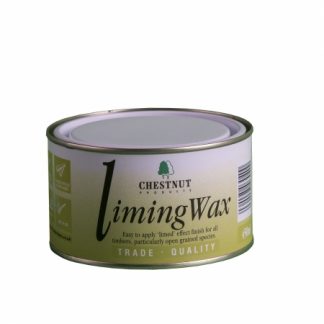 The white pigment in Liming Wax is Titanium Dioxide (TiO2) which gives it a brilliant white finish which will perfectly highlight open grain. Use Liming Wax on any open grained timber for a dramatic and striking effect which can be emphasised by using a stain or Ebonising Lacquer first. For an even better result use the Liming Brush first to open up the grain, allowing more Liming Wax to enter; spread the Liming Wax over the whole surface and then wipe off after a few minutes. The Liming Wax will stay in the open grain and the effect will be instantly visible. Whilst Liming Wax is a wax (obviously!), the wax is mainly a carrier for the white pigment. Therefore an overcoat of some kind is needed. WoodWax 22, Microcrystalline Wax, Finishing Oil or Hard Wax Oil are ideal for this and will lock the wax in place whilst keeping it clean and bright.
The white pigment in Liming Wax is Titanium Dioxide (TiO2) which gives it a brilliant white finish which will perfectly highlight open grain. Use Liming Wax on any open grained timber for a dramatic and striking effect which can be emphasised by using a stain or Ebonising Lacquer first. For an even better result use the Liming Brush first to open up the grain, allowing more Liming Wax to enter; spread the Liming Wax over the whole surface and then wipe off after a few minutes. The Liming Wax will stay in the open grain and the effect will be instantly visible. Whilst Liming Wax is a wax (obviously!), the wax is mainly a carrier for the white pigment. Therefore an overcoat of some kind is needed. WoodWax 22, Microcrystalline Wax, Finishing Oil or Hard Wax Oil are ideal for this and will lock the wax in place whilst keeping it clean and bright.
-
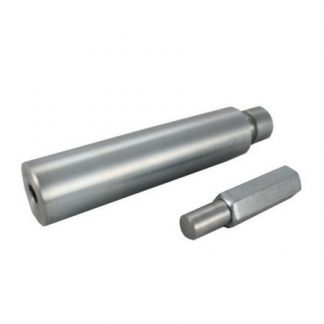 These Mandrels are available separately or come as part of the buffing wheel kit. Both Mandrels are made in the UK and are zinc plated for maximum protection. Due to the limitations of plating a blind hole care should be taken to ensure the tapped thread of the large mandrel stays as dry as possible. The large mandrel is designed to be held in a lathe chuck. It is 25mm in diameter at its widest part, stepped to 18mm with an undercut for smaller chucks. It can be held on either, both will still give plenty of clearance from the chuck. The small mandrel is designed to be held in a jacobs chuck or similar and is especially suited to use with the smaller 4 inch wheels and the Dome Buffs.
These Mandrels are available separately or come as part of the buffing wheel kit. Both Mandrels are made in the UK and are zinc plated for maximum protection. Due to the limitations of plating a blind hole care should be taken to ensure the tapped thread of the large mandrel stays as dry as possible. The large mandrel is designed to be held in a lathe chuck. It is 25mm in diameter at its widest part, stepped to 18mm with an undercut for smaller chucks. It can be held on either, both will still give plenty of clearance from the chuck. The small mandrel is designed to be held in a jacobs chuck or similar and is especially suited to use with the smaller 4 inch wheels and the Dome Buffs. -

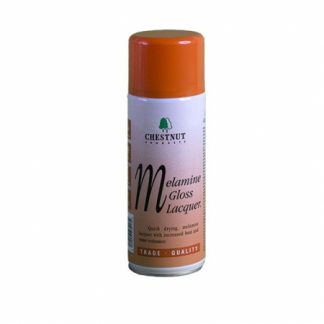
 Melamine Lacquer can be a bit fiddly to apply and there’s no better way than spraying it. If you don’t have access to spray equipment then this aerosol version is the ideal way.
Melamine Gloss Lacquer will quickly build to a bright gloss finish and dries in a matter of minutes.
Touch dry and safe to handle within five minutes the lacquer chemically cures to give a tougher finish. The lacquer achieves practically all of this (about 90%) within seven days, after which the process slows and can take up to another two weeks to fully complete.
Best used over a Cellulose Sanding Sealer (brushing or aerosol) and can be overcoated with a wax for a softer tactile feel.
Melamine Lacquer can be a bit fiddly to apply and there’s no better way than spraying it. If you don’t have access to spray equipment then this aerosol version is the ideal way.
Melamine Gloss Lacquer will quickly build to a bright gloss finish and dries in a matter of minutes.
Touch dry and safe to handle within five minutes the lacquer chemically cures to give a tougher finish. The lacquer achieves practically all of this (about 90%) within seven days, after which the process slows and can take up to another two weeks to fully complete.
Best used over a Cellulose Sanding Sealer (brushing or aerosol) and can be overcoated with a wax for a softer tactile feel.

-

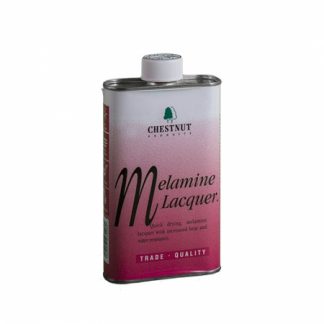
 When you’re looking for a hard-wearing, heat and water resistant, quick drying gloss lacquer you need look no further than Melamine Lacquer.
Based on cellulose technology, Melamine Lacquer has a catalyst suspended within it; when the lacquer is in the can it is inert but once applied and exposed to the air, the lacquer dries within five minutes like a cellulose and then the catalyst kicks in and the lacquer goes on to chemically cure to give a more durable coating. 90% of the curing process happens in the first seven days after application, making the lacquer very hard wearing, the remaining 10% of the process can take up to two weeks more to give maximum toughness, something you only need to consider if the lacquer is going to be subjected to extremely hard use.
Melamine Lacquer is designed to give a full gloss finish which will be achieved with a very careful application. It can be applied by brush (foam or bristle), cloth or by spraying. Where necessary, use cellulose thinners to dilute the product – especially helpful if working on a large area.
The gloss level of Melamine Lacquer can be increased by using burnishing cream once it has dried, and it can also be overcoated with friction polish (to increase the depth of the shine) or woodwax 22 or microcrystalline wax (for a more natural feel).
When you’re looking for a hard-wearing, heat and water resistant, quick drying gloss lacquer you need look no further than Melamine Lacquer.
Based on cellulose technology, Melamine Lacquer has a catalyst suspended within it; when the lacquer is in the can it is inert but once applied and exposed to the air, the lacquer dries within five minutes like a cellulose and then the catalyst kicks in and the lacquer goes on to chemically cure to give a more durable coating. 90% of the curing process happens in the first seven days after application, making the lacquer very hard wearing, the remaining 10% of the process can take up to two weeks more to give maximum toughness, something you only need to consider if the lacquer is going to be subjected to extremely hard use.
Melamine Lacquer is designed to give a full gloss finish which will be achieved with a very careful application. It can be applied by brush (foam or bristle), cloth or by spraying. Where necessary, use cellulose thinners to dilute the product – especially helpful if working on a large area.
The gloss level of Melamine Lacquer can be increased by using burnishing cream once it has dried, and it can also be overcoated with friction polish (to increase the depth of the shine) or woodwax 22 or microcrystalline wax (for a more natural feel).


